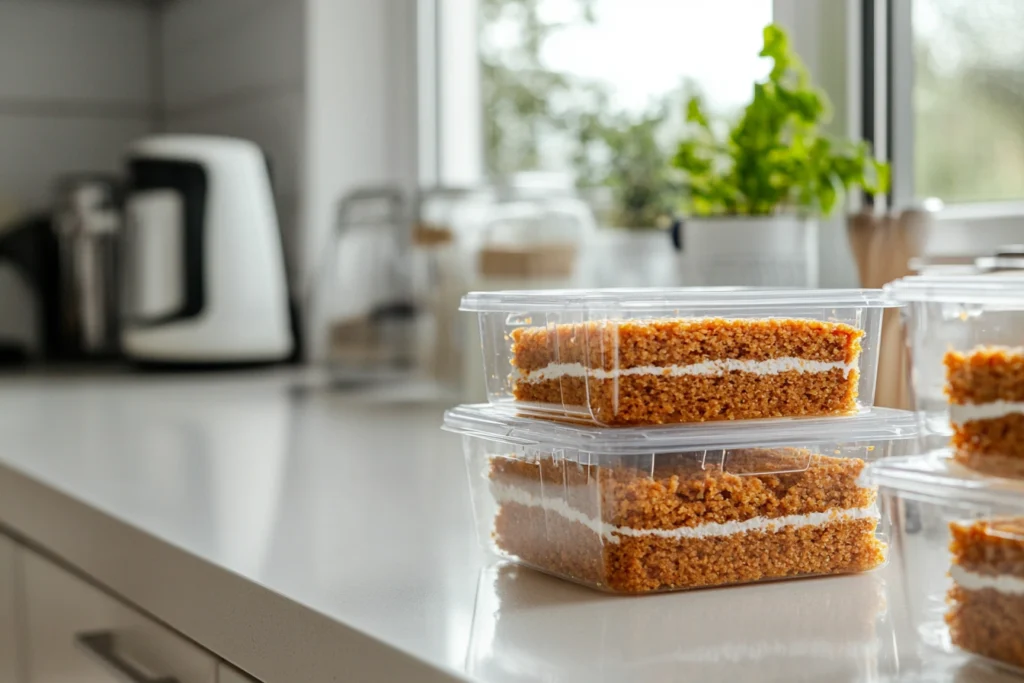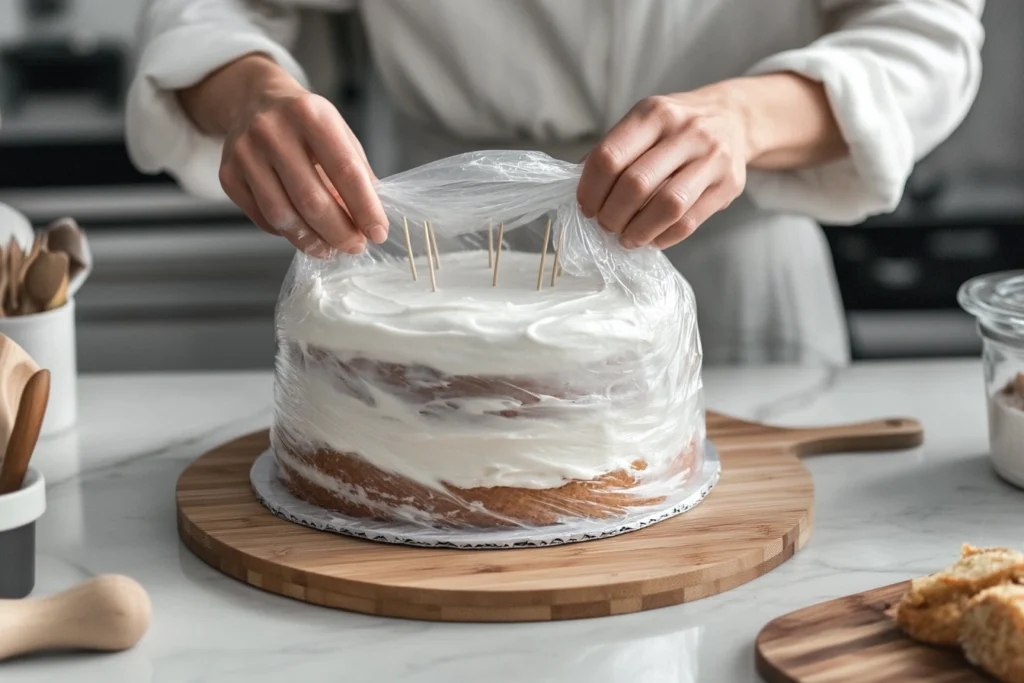Carrot cake storage isn’t just some dry fridge talk—it’s the difference between “Mmm, still moist!” and “What is this… drywall?” Whether you’ve baked a masterpiece or hoarded leftovers like a dessert goblin (no shame), knowing where and how to stash that sweet slab matters big time. We’re talkin’ fridge, freezer, frosting drama, and cake-saving hacks so good, even your Aunt Susan would approve. Let’s keep your carrot cake as fresh as your best baking comeback.

Table of Contents
Refrigerating Carrot Cake Like a Pro

Best Way to Refrigerate Carrot Cake With or Without Frosting
Whether your carrot cake is topped with cream cheese frosting or left plain, the refrigerator is your best friend for keeping it fresh beyond the first couple of days. But how you refrigerate it makes all the difference between a moist slice and a sad, dried-out mess.
Here’s how to do it right:
- Let it cool completely before storing to avoid condensation (which leads to sogginess).
- Wrap the cake tightly with plastic wrap or place it in an airtight container.
- If it’s a whole cake, consider slicing it first to make it easier to serve later—and store slices with parchment paper between them to keep the frosting intact.
Pro Tip: Add a piece of bread inside the container—it helps retain moisture, keeping your cake softer for longer.
| Storage Step | Purpose |
|---|---|
| Cool completely | Prevents condensation & sogginess |
| Wrap tightly | Keeps out fridge odors & air exposure |
| Store in container | Adds double layer of freshness |
| Bread trick | Preserves cake’s moisture |
How Long Can You Keep Carrot Cake in the Fridge?
Once safely packed and stored in the refrigerator, carrot cake lasts for 5 to 7 days. The cream cheese frosting acts as both a flavor boost and a shelf-life limiter—it’ll go bad before the cake does.
Check daily for any signs of spoilage like sour smells or a change in texture. If your cake’s starting to feel sticky or overly moist, that’s your cue it’s nearing its end.
Important Reminder: Always return leftover slices to the fridge within an hour after serving—this helps prevent the frosting from becoming a breeding ground for bacteria.
If you’ve ever prepped dinner in advance, you’ll understand the same value of smart storage. Learn more about prepping protein-rich dishes like this Ground Chicken Stir Fry for easy mealtimes.
Freezing Carrot Cake for Long-Term Storage

How to Freeze Whole Carrot Cakes vs. Slices
Freezing carrot cake is a brilliant move when you want to bake ahead or preserve leftovers without sacrificing quality. The good news? Carrot cake freezes exceptionally well thanks to its moisture-rich ingredients like grated carrots, oil, and sometimes pineapple.
There are two main freezing strategies: whole cake or individual slices. Here’s how to do both.
Freezing a Whole Carrot Cake:
- Step 1: Chill the cake in the fridge for 1 hour to firm up the frosting.
- Step 2: Wrap the entire cake tightly in plastic wrap, then again in aluminum foil.
- Step 3: Place in a freezer-safe cake container or airtight bag.
Freezing Individual Slices:
- Step 1: Slice the cake and freeze slices on a baking tray for 1–2 hours.
- Step 2: Once solid, wrap each slice in plastic wrap.
- Step 3: Store them in a zip-top freezer bag or airtight container.
Both methods can preserve freshness for up to 3 months if wrapped well.
| Freezing Method | Ideal For | Storage Time |
|---|---|---|
| Whole cake | Parties, planned desserts | Up to 3 months |
| Sliced cake | Single servings, lunches | Up to 3 months |
Don’t miss our Beef Stew Seasoning if you’re planning on stocking your freezer with cozy meals and treats alike.
How to Thaw Frozen Carrot Cake Properly
The key to thawing carrot cake is patience. Quick thawing methods (like microwaves) will ruin the texture and melt the frosting. Here’s the best way to bring your cake back to life:
- Refrigerator Thaw: Move the cake (still wrapped) from the freezer to the fridge for 8–12 hours.
- Room Temp Finish: Unwrap and let sit at room temperature for 30–60 minutes before serving.
For frosted cakes, always thaw in the fridge to protect the integrity of the cream cheese topping.
Storing Carrot Cake with Cream Cheese Frosting

Why Cream Cheese Frosting Needs Different Storage
Cream cheese frosting may be the crown jewel of carrot cake, but it’s also the most delicate. Unlike butter-based frostings that can tolerate short periods at room temperature, cream cheese is perishable and highly sensitive to temperature changes.
The USDA recommends refrigerating anything made with cream cheese within two hours of preparation or serving. That means once your carrot cake is frosted, it becomes a refrigerator-only dessert.
This frosting contains dairy, making it a target for bacteria if left out. Even if it doesn’t “look” spoiled, it may already have developed harmful microbes after sitting out overnight. Trust us—it’s not worth the risk.
Pro Tip: Always refrigerate the cake if you’re unsure about the frosting ingredients.
Safe Time Frames and Temperature Guidelines
Want to know exactly how long you can keep carrot cake with cream cheese frosting? Here’s your cheat sheet:
| Storage Method | Time Limit | Notes |
|---|---|---|
| Room Temperature | Max 2 hours | Must be stored below 70°F |
| Refrigerated (airtight wrap) | 5–7 days | Best consumed within 3–4 days |
| Frozen (wrapped properly) | Up to 3 months | Thaw overnight in the fridge |
If your kitchen tends to get warm, cut that 2-hour window down to 1 hour. Cream cheese frosting can start to “sweat” and lose its stability if left out too long, even before it spoils.
Thinking about planning ahead? Discover great ideas like this Vegan Spinach Quiche that pair beautifully with your stored dessert plans.
Storage Containers & Wrapping Techniques
Best Containers for Fridge and Freezer
Whether you’re tucking your carrot cake into the fridge for a couple of days or freezing it for long-term use, the right container can make or break freshness.
For Fridge Storage:
- Airtight cake keeper: Ideal for whole cakes; prevents drying and odor absorption.
- Glass or plastic containers with snap lids: Great for sliced pieces; easy to stack and seal.
- Cloche domes: Perfect if you’re refrigerating temporarily and want it to look good for serving later.
For Freezer Storage:
- Freezer-safe plastic containers: Must be moisture-resistant and BPA-free.
- Zip-top freezer bags: Great for individual slices; make sure to remove as much air as possible.
- Double-wrap method: First in plastic wrap, then foil—this prevents freezer burn and maintains texture.
| Container Type | Best For | Tip |
|---|---|---|
| Airtight cake keeper | Whole cakes (fridge) | Place parchment under cake to avoid stick |
| Plastic/glass containers | Slices (fridge) | Layer with wax paper for easy removal |
| Freezer-safe bags | Slices (freezer) | Label with date to track shelf life |
Looking for more make-ahead friendly dishes? Check out this Teriyaki Chicken Stir Fry with Noodles—a weeknight hero just like your stored carrot cake.
How to Wrap Carrot Cake for Freshness
Airtight wrapping is crucial to prevent drying out, odor absorption, and freezer burn.
Here’s the perfect wrap technique:
- Use plastic wrap to tightly cover the entire cake or slices.
- If freezing, wrap again with aluminum foil for insulation.
- Add a label with the date and type of cake.
- For frosted cakes, place in a container after wrapping to preserve decoration and frosting shape.
Storage Hack: Insert a couple of toothpicks on the top of the cake before wrapping to prevent the plastic wrap from sticking to the frosting.
When you’re done baking and wrapping, don’t forget to restock your fridge with easy meals like this Chicken Cabbage Stir Fry—another flavor-packed dish that stores like a dream.
Carrot Cake Storage Mistakes to Avoid
Even seasoned bakers slip up when it comes to storing carrot cake. To make sure your dessert stays safe, delicious, and moist, here are the most common mistakes people make—and how to avoid them.
Leaving It Uncovered
This one’s a killer—literally for the cake’s texture.
Leaving carrot cake uncovered in the fridge or on the counter leads to rapid moisture loss. That signature softness you love? It’s gone overnight if the air gets to it.
Always wrap your cake tightly or store it in a sealed container. This applies to both frosted and unfrosted cakes. Frosting doesn’t act as a full barrier—it can dry out just like the crumb.
Quick Tip: Even a paper towel tent is better than nothing if you’re out of containers—just cover it loosely and eat it within a day.
Refreezing After Thawing: Yay or Nay?
Hard no. Once you thaw carrot cake, don’t refreeze it. Freezing and thawing changes the structure of baked goods. Refreezing causes more moisture separation, resulting in soggy, gritty, or flavorless cake.
Here’s what to do instead:
- Freeze individual slices so you can pull out only what you need.
- If you thaw a whole cake, plan to serve or finish it within a few days.
- Share leftover slices with friends or freeze them before frosting.
| Mistake | Why It’s Bad | What to Do Instead |
|---|---|---|
| Storing cake unwrapped | Dries out quickly | Use plastic wrap + container |
| Leaving out frosted cake | Risk of bacteria growth | Refrigerate within 1–2 hours |
| Refreezing thawed cake | Texture and taste degrade | Slice & freeze individually from the start |
| Storing in warm environments | Speeds spoilage of frosting | Store below 70°F or refrigerate immediately |
Don’t miss our Spinach Artichoke Quiche if you’re hosting brunch and want another baked dish that benefits from storage smarts.
FAQ
Can you leave carrot cake with cream cheese frosting out overnight?
No, you shouldn’t. Cream cheese frosting is made from dairy and must be refrigerated within 2 hours to stay food-safe. Leaving it out overnight can lead to bacterial growth—even if it looks fine. Always refrigerate frosted carrot cake in an airtight container.
Can I make a carrot cake 2 days in advance?
Yes, and it’s actually a great idea! Bake the layers and refrigerate or freeze them, then frost the cake closer to your serving day for the best texture. Fully frosted cakes can also be stored in the fridge for up to 3 days—just be sure to cover them well.
Can you leave carrot cake with cream cheese frosting out overnight?
Nope, not a good idea. Cream cheese frosting needs refrigeration—leaving it out more than 2 hours could invite bacteria to the party. Pop it in the fridge.


1 thought on “Carrot Cake Storage: Keep Your Cake Fresh and Delicious”